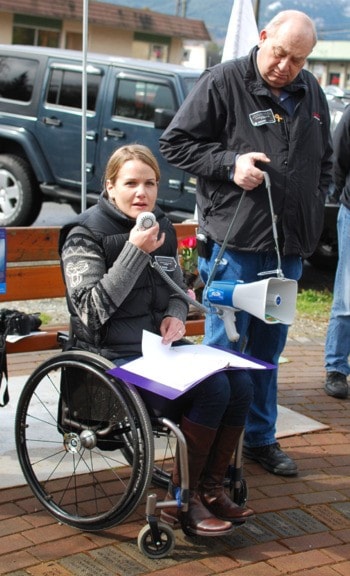No workplace-related deaths or injuries.
Highlighting tragedies of the past, those attending the annual Day of Mourning ceremony at the Forest Workers’ Memorial Park, Thursday, April 28, have set this ambitious goal.
“We need to educate our workers and let them know that they don’t have to be in harm’s way,” Nanaimo Labour Council president Ellen Oxman said, during the ceremony around the forest Workers’ Memorial Park fountain.
Putting statistics to workplace deaths and injuries, Worksafe BC investigating officer Mohinder Bhatti said that there were 143 workers in the province that died of work-related injury, illness, or disease.
“These deaths are more than statistics,” she said.
Although these are the lowest rates in Canada, she said that there shouldn’t be any at all.
Mistakes of the past are still being paid for today, she said. Occupational diseases that are a result of asbestos and other hazardous material exposure, even decades ago, are still affecting people.
“Even a small particle inhaled.... That person can develop a deadly form of lung cancer,” she said.
“Prevention, that is our goal,” she concluded.
Putting a face to workplace injuries and deaths was Victoria paralympian Jessica Vliegenthart.
In 2004, five days before her 21st birthday, Vliegenthart became paralysed as a result of the fire truck she was sitting in going off the road and crashing.
“My life changed in just second,” she said. “The pain was so bad I thought an axe was thrown in my back,”
Rehabilitation wasn’t an easy process. Following the incident, two-thirds of her muscle mass had to be re-gained, and she had to undergo daily physiotherapy.
“It’s not like breaking a leg. Breaking a back takes months and months of re-learning,” she said.
She’s since gone back to law school, and has begun wheelchair racing, and has even played on the women’s national wheelchair basketball team.
“I know that I’m lucky I wasn’t killed,” she said, of the incident that forever changed her life. “Everyone needs to pay attention to safety.”
People have legal rights to refuse unsafe work, she told the crowd.
“In my work career, I lost a half dozen close friends,” North Cowichan mayor Tom Walker said. “If you go to work in the morning, I think you have the right to get home alive and uninjured.”
Canadian Auto Workers representative Jim Sadlemyer lost a brother only six days before the April 28 memorial event. It was a result of a heart attack, which he refers to as a workplace condition related to stress and eating fast food on the go.
Related to the forestry industry, and the great improvements made in the realm of safety, is the Kaatza Station Museum’s massive collection of IWA Local 1-80’s archives, which include many Wilmer Gold photographs of forestry practices.
The grand opening of the collection, which dates from the 1890s to 2009, will take place at Lake Cowichan’s Centennial Hall during Heritage Days, Saturday, May 21, beginning at 1 p.m.
